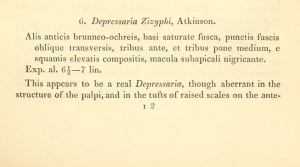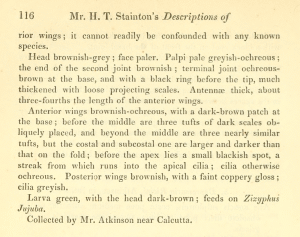3. Biologie
3.1. Nahrung der Raupe
- [Rutaceae:] Citrus limon (Zitrone)
- [Rutaceae:] Citrus reticulata (Mandarine)
- [Rutaceae:] Murraya koenigii (Currybaum)
- [Rutaceae:] Aegle marmelos (Bengalische Quitte)
- [Rutaceae:] Limonia acidissima [= Feronia elephantum] (Indischer Holzapfel, Elefantenapfel)
- [Rutaceae:] Glycosmis pentaphylla (Orangenbeere)
- [Simaroubaceae:] Ailanthus excelsa (Indischer Götterbaum)
- [Rhamnaceae:] Zizyphus jujuba ? (Chinesische Jujube ?)
Stainton (1859: 116) informiert in seiner Erstbeschreibung: "Larva green, with the head dark-brown; feeds on Zizyphus jujuba. Collected by Mr. Atkinson near Calcutta." So ganz sicher ist diese Meldung wohl nicht, denn in der Folge werden - neben Ailanthus excelsa - nur noch Zitrusgewächse als Nahrung genannt.
Lvovsky & Fallahzadeh (2010) fassen zusammen: "In first description was told “Larva green, with the head dark-brown; feeds on Zizyphus jujuba” (Stainton, 1859). Later, the species was known as a pest of citrus. The larvae shelter in longitudinally rolled leaves and damage the young terminal foliage, sometimes seriously (Common, 1990)."
Am wichtigsten sind hier unter den Rutaceae sicher Citrus limon und Citrus reticulata, aber auch von Murraya koenigii, Aegle marmelos und Limonia acidissima [= Feronia elephantum] werden regelmäßige Schäden genannt, von Glycosmis pentaphylla wenigstens einzelne.
Der Titel der Arbeit von Misra et al. (1989) klingt sehr danach, als ob auch Ailanthus excelsa (Simaroubaceae) eine größere Rolle als Raupennahrung von P. zizyphi spielen müsste - ich habe die Originalarbeit noch nicht studiert.
(Autor: Erwin Rennwald)
4. Weitere Informationen
4.1. Andere Kombinationen
- Depressaria zizyphi Stainton, 1859 [Originalkombination]
4.2. Faunistik
Die Art wurde aus der Umgebung von Kalkutta in Indien beschrieben. Lvovsky & Fallahzadeh (2010) melden sie erstmals aus dem Süden des Iran ("Hormozgan, Minab, 8-16.IX 2006, 4 ♂ (F. Kamyab leg."). Sie fassen den aktuellen Kenntnisstand zur Verbreitung zusammen: "Psorosticha zizyphi is widely distributed from United Arab Emirates, India, Sri Lanka, Chine, Vietnam, Philippines, Indonesia, New Guinea and Australia (Meyrick, 1922; Lvovsky, 1988, 2009; Common, 1990, 1996). New record of the species from Iran is the most northern point of its distribution."
Der erste Bericht eines Nachweises der Art in Australien scheint der von Davis (1965) zu sein, der über kleinere Schäden an Citrus sinensis in Pflanzungen in Queensland berichtet: "The citrus leaf roller, Psorosticha zizyphi (Stnt.) (Lepidoptera: Oecophoridae), a well known pest of citrus in India and Ceylon (Gupta 1954, Hutson and Pinto 1934), is herein recorded as a citrus pest in Queensland. QUEENSLAND : reared from larvae rolling leaves of Citrus sinensis Osbeck var. Washington Navel, a common leaf roller on a few trees, Gayndah, 13.ii.1959 (W. A. Smith); reared from larvae rolling leaves of Citrus sinesis [sic!] var. Washington Navel, common, causing serious damage to young growth, Palmwoods, 11.i.1965 (J. J. Davis). Mr. I.F.B. Common of CSIRO, Division of Entomology, who identified the above material, states that the species has been recorded also from Brisbane, Cooktown and Townsville, but not as a pest of citrus (personal communication). Both records on citrus were in commercial orchards. At Palmwoods, in the one orchard on which it occurs, P. zizyphi has damaged trees each year for at least the past few years. The larvae fold leaves longitudinally, attacking only the tender new growth, and damage is most serious during the summer from November to March. The young leaves are eaten completely or fall, leaving new growth with a ragged appearance. During the summer the growth flushes which appear on the trees may be com- pletely destroyed, and this is considered to cause a serious setback to tree vigour. On the Palmwoods orchard the insect has been controlled with parathion sprays."
Diakonoff (1958) meldet die Art aus dem Süden Chinas ("Canton, on Citrus, 28. X. 1956 (S. K. Liu).") und merkt dazu an: "It may be stated here that the common Citrus pest in Java, usually identified as Psorosticha zizyphi Stainton (e. g., in Kalshoven, „De Plagen van Cultur-gewassen in Indonesië“, 1, 382, 1950), is certainly not this species. It is much larger and has distinctly different genitalia (in the two sexes). I identified it previously as P. acrolopha Lower, an Australian species, but the matter needs confirmation which I hope to provide in due course. Records of zizyphi from the Malay Archipelago, the Papuan Region, and Australia, pertain, in my opinion, not to zizyphi, but to the larger species or to a third one."
(Autor: Erwin Rennwald)
4.3. Literatur
- Ashwini, A. & M.G. Hedge (2022): Seasonal incidence of leaf roller, Psorosticha zizyphi (Stainton) (Lepidoptera: Oecophoridae) on curry leaf, Murraya koenigii (L.) Sprengel and its management. — Pest Management in Horticultural Ecosystems, 28 (1): [Sekundärzitat nach dem Abstract auf [pmhe.in]
- Davis, J.J. (1965): The citrus leaf roller Psorosticha zizyphi (Stnt.) in Queensland (Lepidoptera: Oecophoridae). — Australian Journal of Entomology, 4 (1): 68. [PDF auf wiley.com]
- Devaki, K., Muralikrishna, T., Sreedevi, K. & A. Rao (2012): Incidence and biology of leaf roller, Psorosticha zizyphi (Stainton) (Lepidoptera: Oecophoridae) on curry leaf, Murraya koenigii (L.) Sprengel. — Pest Management in Horticultural Ecosystems, 18 (2): 154-157. [Sekundärzitat nach dem Abstract auf [semanticscholar.org]]
- Diakonoff, A. (1958): A Note on M icrolepidoptera from South China (Lepidoptera: Tortricidae & Oecophoridae). — Beiträge zur Entomologie, 8: 118-122. [PDF auf zobodat.at]
- Lvovsky, A.L. & M. Fallahzadeh (2010): Psorosticha zizyphi (Lepidoptera: Depressariidae) is newly recorded from Iran. — Far Eastern Entomologist, 216: 14-16. [zum PDF-Download auf researchgate.net]
- Misra, R.M., Prasad, G. & R.K. Misra (1989): Bionomics of the Ailanthus leaf roller Psorosticha zizyphi Stainton (Lepidoptera: Oecophoridae). — Indian Forester, 115: 398-403. [Sekundärzitat]
- Erstbeschreibung: Stainton, H. T. (1859): Descriptions of Twenty-Five Species of Indian Micro-Lepidoptera. — The Transactions of the Entomological Society of London. New Series 5 (2): 111-126.
- Tara, J.S., Sharma, M. & M. Chhetry (2011): Incidence of Psorosticha zizyphi Stainton (Lepidoptera: Oecophoridae), a leaf roller on Murraya koenigii (Curry Leaf) and Citrus sp. in Jammu, J&K. — Journal of Entomological Research, 35 (4): 331-333. [Sekundärzitat nach dem Abstract auf [researchgate.net]]




![Vorkommen in Iran [Rajaei & al. (2023); Lvovsky & Fallahzadeh (2010)]](/res/img/flag/ir.gif)
![Vorkommen in den Vereinigten Arabischen Emiraten [Lvovsky & Fallahzadeh (2010)]](/res/img/flag/ae.gif)
![Vorkommen in China [Diakonoff (1958)]](/res/img/flag/cn.gif)
![Vorkommen in Indien (Festland) [Locus typicus]](/res/img/flag/in.gif)
![Vorkommen in Sri Lanka [Lvovsky & Fallahzadeh (2010)]](/res/img/flag/lk.gif)
![Vorkommen in Vietnam [Lvovsky & Fallahzadeh (2010)]](/res/img/flag/vn.gif)
![Vorkommen auf den Philippinen [Lvovsky & Fallahzadeh (2010)]](/res/img/flag/ph.gif)
![Vorkommen in Indonesien [Lvovsky & Fallahzadeh (2010)]](/res/img/flag/id.gif)
![Vorkommen in Australien [Davis (1965]](/res/img/flag/au.png)



